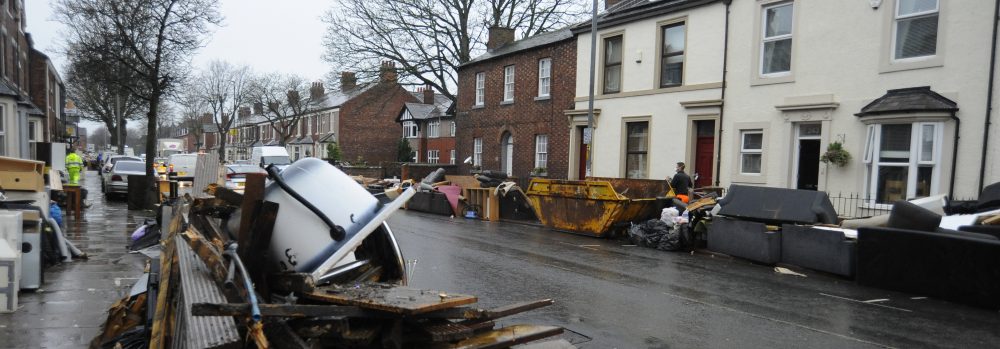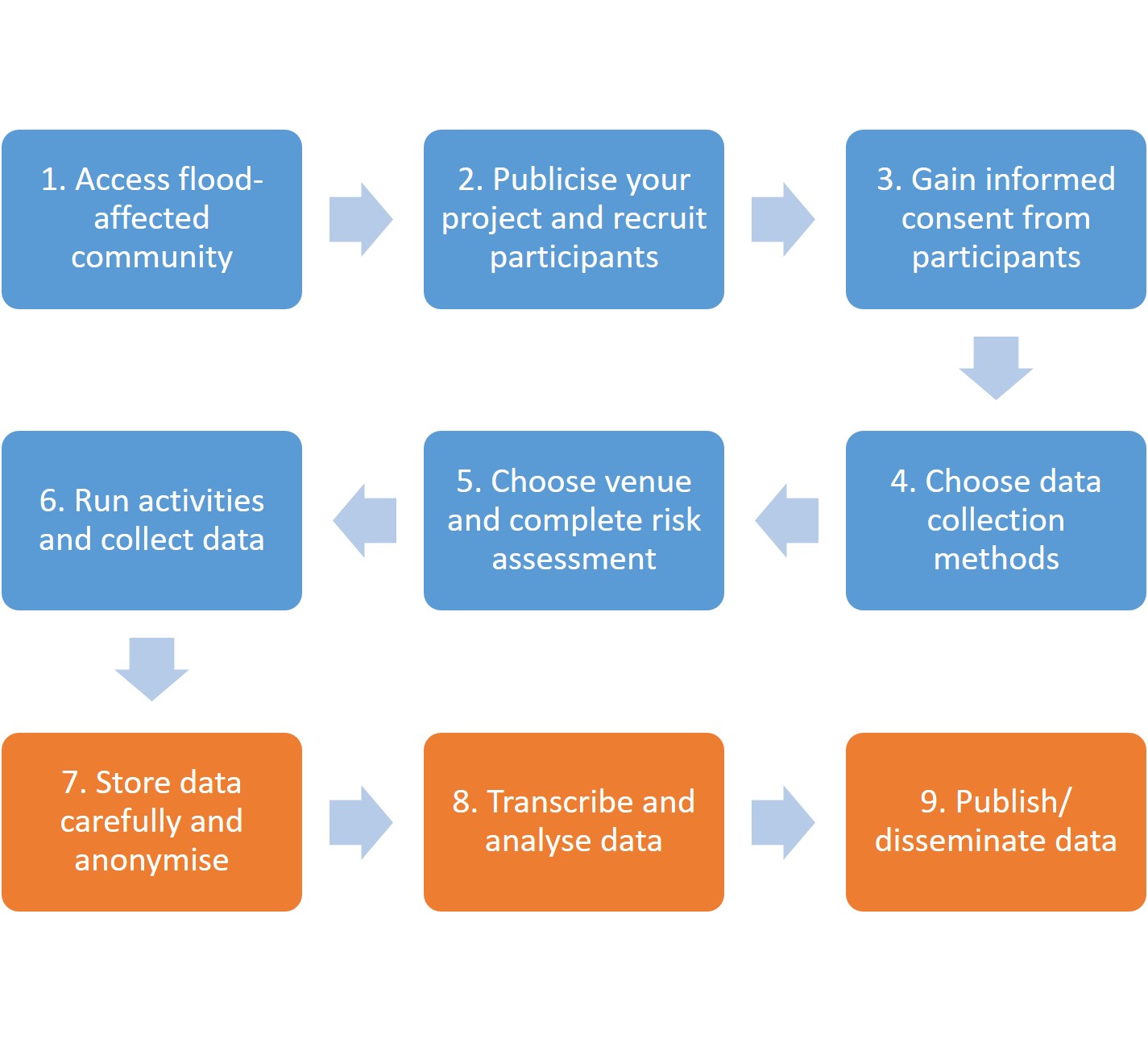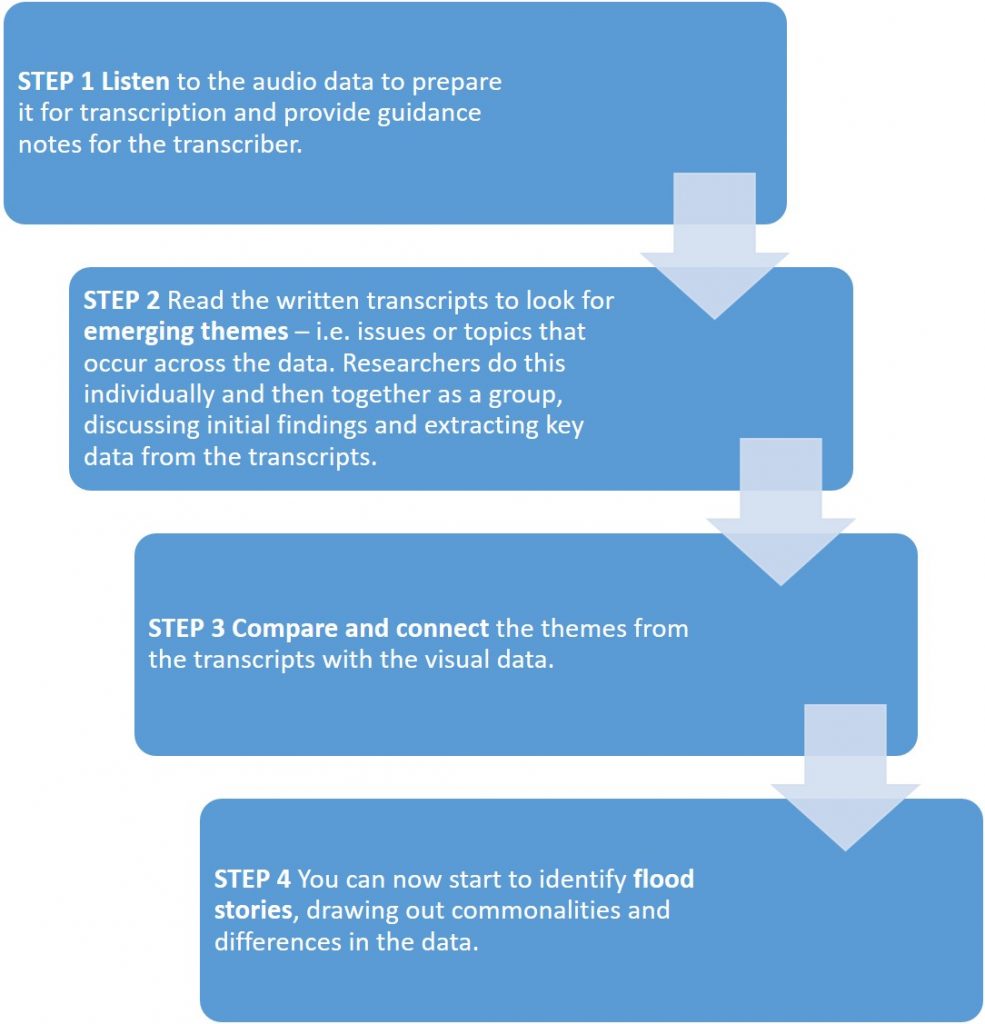Here you will explore:
- reasons for analysing data
- four steps to data analysis
- two examples of data analysis from the Children, Young People and Flooding project
Why analyse data? Data you have collected can be used simply as evidence of your community engagement activity, but it can also be analysed to better understand people’s experiences and perspectives and help develop further flood resilience work or support decision making.
Data analysis flowchart Here are four basic steps to data analysis:
*Because of the huge amount of data produced during the Children, Young People and Flooding project, and because of the poor conditions in which much of the data was recorded (e.g. outside in windy conditions, or indoors in a noisy workshop setting), it was only possible to transcribe sections of the data from the Group Conversations.
Example 1 One major theme that emerged during the analysis of the Children, Young People and Flooding Project was Children as active contributors in flood response and recovery.
In the transcripts the team found instances of children describing how they had been actively engaged both in the immediate response to the flood events and during the recovery process. Examples included checking on neighbours, helping to move their own and other people’s furniture upstairs and joining in with the clean-up.
| Daniel, aged 14:
We’ve a lot of elderly people down our road. I wanted to help them – they had no one. I went to see if they wanted anything taking upstairs. |
Richard, aged 14:
I had to unplug all the electricals, put the speakers up high. We also had to stack a sofa on a sofa, put chairs and the rug on top… to make sure they were safe. |
The children and young people generally described this role as a positive one, expressing satisfaction about how they had been able to support others in difficulty. For example, Sara served tea and coffee to evacuated families and rescue teams at her local village hall and Avril and Helena gave up a riding lesson to help clean up their friend’s house.
| Sara, aged 14:
I felt quite good at myself then. I could have been home just watching TV and I was actually constructive and helping people.. |
Avril, aged 9 and Helena aged 10:
No way would we have let our friend have to do it all herself… because we would be guilty. We didn’t even have to make a choice. |
One young man, aged 19 at the time and a university student, described his role with a community volunteer group, formed in response to the flooding. The youngest member of the team, he went out delivering sandbags and food parcels in what he described as ‘hazardous conditions’:
…It sounds horrible … I’m taking personal achievement out of dealing with someone’s house but… I don’t know, there’s a sense of pride… There’s a sense of pride in that.
Example 2 Another important theme that emerged from this project was Children’s understanding of flood adaptation and new normalities.
The transcripts highlighted the children’s high level of ‘flood awareness’. This was shown by their concern about the likelihood of further flooding and a fear that that the community had not taken measures to prepare for next time and just wanted to get ‘back to normal’:
| Jodi, aged 14:
I’m just kind of like worried it’s going to happen again this year… I suppose I’m going to worry every year, though. Even if it doesn’t happen, we’re still going to worry. |
Daniel, aged 14:
… People do kind of forget about what it was like a year ago… They forget it could happen again. |
At the same time, many of the young people demonstrated an understanding of the need for families and communities to adapt to a ‘new normal’ that ensured they were prepared. Britney, aged 8 described her family’s plans:
We’ve sorted out next time. We’ve got a flood toilet… The floodwater can’t go inside it… And then we’re gonna turn all the lights off… and we’re gonna go upstairs. And then we’re gonna put some candles on… And we’re gonna get loads of food.

Richard’s Resilience Raft
The data included a photograph of a model Richard had made of a person sitting on a raft. The transcripts revealed his reasons for making this and his understanding of the need for communities to learn to live with flood risk:
It’s a little raft and there’s a person sitting on it. They’re all prepared… They didn’t realise that it would have ever flooded but now they realise that it will more than likely flood again, so they’ve bought themselves a little raft that I made…
Richard, aged 14
In the case of the Children, Young People and Flooding project, the team identified six main themes from the data that later became principal research findings. These findings are explained in our Children Young People and Flooding Report and expanded on in academic papers and flood narratives.
Please reference as: Flooding – a social impact archive, Lancaster University


